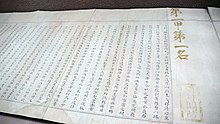| Zhuangyuan | |||||||||||
|---|---|---|---|---|---|---|---|---|---|---|---|
 Imperial exam paper of Ming dynasty Zhuangyuan Zhao Bing-zhong in 1598 AD | |||||||||||
| Chinese name | |||||||||||
| Traditional Chinese | 狀元 | ||||||||||
| Simplified Chinese | 状元 | ||||||||||
| Hanyu Pinyin | zhuàngyuán | ||||||||||
| |||||||||||
| Vietnamese name | |||||||||||
| Vietnamese alphabet | trạng nguyên | ||||||||||
| Chữ Hán | 狀元 | ||||||||||
Zhuangyuan, or trạng nguyên in Vietnamese, variously translated into English as principal graduate, primus, or optimus,[1] was the title given to the scholar who achieved the highest score on highest level of the Imperial examination, Metropolitan examination (in the Tang dynasty) and Palace examination (in the Song dynasty)[2] in ancient China and Vietnam.
In China, Fu Shanxiang is known as the first (and last) female zhuangyuan (nü zhuangyuan) in Chinese history, but under the Taiping Heavenly Kingdom, not the regular imperial exams. After the Taipings captured the city of Nanjing, they offered an exam for women in January 1853 in which Fu attained the highest score.[3]
In Vietnam, the first de facto trạng nguyên was Lê Văn Thịnh, a Lý dynasty scholar. He was the chief negotiator who persuaded the Song to return the 6 districts of Quảng Nguyên (today Hà Giang province) to Vietnam. Nevertheless, the first Vietnamese person to be trạng nguyên was in fact Khương Công Phụ under Chinese Tang Dynasty. The first female trạng nguyên (nữ trạng nguyên) was Nguyễn Thị Duệ, who later become a consort of the Mạc Emperor Mạc Kính Cung. She had previously been a consort of the Lê Emperor Lê Thần Tông, and would serve as an official in the Revival Lê dynasty after the fall of the Mạc dynasty.[citation needed] Under Nguyễn Dynasty, the title trạng nguyên was not officially abolished, yet its standards were too high that it was virtually unachievable.[4]
- ^ *Hucker, Charles O. (1985). Dictionary of Official Titles of Imperial China. Stanford: Stanford University Press. p. 187.
- ^ 萧源锦,《狀元史話》,重庆出版社,1992,ISBN 7-5366-1648-1
- ^ Mao (1998), p. 43.
- ^ "Triều Nguyễn có đặt ra lệ "Bất lập Trạng Nguyên" không?". 23 November 2017.